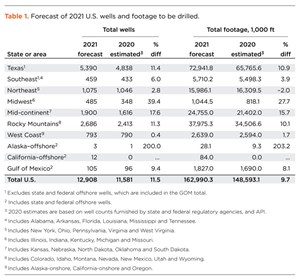Special Focus: 2021 Forecast & Review – U.S. Drilling
Although the industry has experienced many boom-and-bust cycles since its inception, the combination of detrimental factors that occurred in 2020-2021 has made this downturn more intense and destructive than previous events. The outbreak of Covid-19 during first-half 2020 was responsible for an unprecedented decline in demand for transportation fuels and forced many seemingly healthy U.S. operators into bankruptcy or consolidation. This, coupled with the new Biden administration’s push to achieve net-zero greenhouse gas emissions by 2050 and end the use of natural gas by 2035, puts many other U.S. companies at risk and could cause a longer-term decline in demand.
A meaningful recovery in U.S. drilling activity during 2021 will be hampered further by President Biden’s Executive Order that indefinitely blocks new leases and drilling permits on federal lands and waters for up to a year. Some expect the pause to become a long-term ban. However, the moratorium has been challenged in Wyoming federal court by a western-based energy industry group. That industry alliance claims that the president’s order is a violation of the Mineral Leasing Act, the National Environmental Policy Act, the Federal Lands Policy and Management Act. Other opposition to the moratorium has been voiced by virtually every national and state-based industry alliance and lobby group.
Undeterred, Biden also signed a broad-ranging Executive Order directing federal agencies to consider climate change in various government purchases and financial regulations. He instructed U.S. intelligence authorities to estimate how climate change affects national security. Additionally, the pace of any drilling recovery remains highly uncertain, as the trend of Covid-19 cases in the U.S. remains very unpredictable.
How companies respond to these developing challenges may impact traditional operating methods, and determine the shape and direction of the U.S. oil and gas industry for many years. A majority of major operators are increasing investment in alternative energy systems, as companies seek to transform for the long term. A record 66% of senior managers report that their organizations are actively adapting to a less carbon-intensive energy mix in 2021, up from 44% in 2018. Some 57% plan to increase investment in renewables, up from 44% last year, while 50% expect to increase investment in green or decarbonized gas (DNV GL).
OPEC+ cuts stabilize crude markets. In February 2020, U.S. crude production hit a record-high 13.01 MMbopd. However, the flood of crude from U.S. shale fields put downward pressure on global oil prices. In an action designed to quell the unbridled flow of U.S. crude and protect its market share, Saudi Arabia ramped-up its output in April to an all-time high of 12 MMbopd, an increase of 23% from March (9.73 MMbopd). The Saudis’ “shot across the bow” came just as the virus was starting to take hold in the U.S. The flood of supply, coupled with flagging demand, resulted in a 43% decline in WTI to $16.55/bbl in April. In May, Aramco cut back production to 8.49 MMbopd, and WTI shot up 73% to average $28.56/bbl.
For the remainder of 2020, Aramco held production constant at approximately 8.75 MMbopd until December, when the company announced plans to reduce output by 1.0 MMbopd in February and March 2021, as a “gift to other producers.” The unexpected preemptive action was deemed necessary to protect the fledgling oil price recovery from a resurgence of Covid-19. The reduction came just as the IEA slashed its demand forecast for the first quarter, while countries locked down to contain new virus outbreaks. Russia did its part by honoring an OPEC+ commitment (for the most part), averaging roughly 9.3 MMbopd during post-April 2020.
If U.S. producers have learned from past mistakes, and they can keep a lid on production, even as crude rebounds, WTI is projected to average around $50/bbl in 2021. However, major investment firms are skeptical and see little value in producers’ promises of frugality. How the fragmented U.S. shale industry will respond, to increased incentives to drill, has become a crucial question for traders and industry experts around the world. Many industry experts have suggested producers’ discipline won’t last, as oil extends a recovery from historic lows to trade at more than $50/bbl, a level at which many shale wells are profitable. Some companies will exercise restraint for a few months, but there’s too much equipment and expertise, ready to work for shale producers, to hold back after mid-year.
The aforementioned factors, along with World Oil’s surveys of operators and state agencies, have all shaped this cycle’s U.S. forecasting process. Accordingly, World Oil’s editorial staff presents its 2021 E&P forecast, as follows:
- U.S. drilling will increase 11.5%, to 12,908 wells, Table 1
- U.S. footage will increase 9.7%, to 163.0 MMft of hole
- U.S. Gulf of Mexico activity should improve 9.4%, to 105 wells.
U.S. MARKET FACTORS
Although the U.S. stock market has surged in response to the federal government’s fiscal support, another massive stimulus program has yet to hit the economy in early 2021. According to Evercore ISI economist Ed Hyman, who has tracked more than 600 stimulus initiatives since the Covid-19 outbreak, the massive and unprecedented amount of stimulus remains underappreciated. Meanwhile, U.S. consumer net worth is up sharply, and Pfizer, Moderna and AstraZeneca started delivering vaccines in December.
The combination of massive global stimulus and vaccines will be a powerful engine for global economic growth and oil demand in 2021. In addition, the OPEC+ alliance agreed to delay its planned 2.0-MMbopd output boost—scheduled for January—until the second quarter. A better outlook for 2021 is predicated on a rollback of OPEC+ production growth plans, two or more Covid-19 vaccines, and ultimately a resurgence in global demand.
Capex. E&P spending has bottomed says James West, senior managing director at the Evercore ISI investment firm (see page 17). “The third-worst downturn in 35 years is giving way to the start of a new recovery, one we believe is predicated on massive global stimulus and vaccines that will drive global economic growth and oil demand in 2021.” Spending in the U.S. should increase 5.3%, to $61.4 billion in 2021, compared to $58.3 billion in 2020.
Oil production. U.S. crude and condensate production fluctuated in 2020. The year started with operators pumping an average 12.99 MMbopd in January, before hitting an all-time high of 13.10 MMbopd in February (see page 31). Production hit a low point for the year of 10.02 MMbopd in May, before surging back to 11.03 MMbopd in December. EIA estimates that U.S. crude oil production fell from the 2019 record level of 12.2 MMbopd to 11.3 MMbopd in 2020. EIA expects that annual average production will fall to 11.1 MMbopd in 2021 before rising to 11.5 MMbopd in 2022.
Natural gas production. EIA estimates that U.S. dry natural gas production averaged 90.8 Bcfd in 2020, down 2.3 Bcfd (2.5%) from 2019. The decline resulted from low commodity prices that suppressed drilling activity. EIA predicts dry natural gas production will decline again in 2021, to an annual average of 88.2 Bcfd. Gas production will decline to around 87.3 Bcfd in March, but then rise through the rest of the year. Additionally, EIA expects that recent increases in oil prices, plus a forecast of rising natural gas prices, will lead to increased drilling activity that should contribute to production growth after the first quarter.
LNG outlook. EIA estimates that the U.S. exported 9.8 Bcfd of LNG in December 2020, an increase of 0.4 Bcfd over the previous record set in November. The growth was driven by rising natural gas and LNG prices in Europe and Asia, in addition to a reduction in supply caused by unplanned outages at several international LNG export facilities. The U.S. should export an average 8.5 Bcfd in 2021 and 9.2 Bcfd in 2022. Forecast growth in U.S. LNG exports is supported by a gradual post-Covid-19 recovery in global LNG demand in established markets, high winter LNG demand in Asia, and expansions in global LNG import infrastructure. Prices from LNG trades with Japan, South Korea, China and Taiwan averaged $10.82/MMBtu in December, which was the highest monthly average since 2018.
Commodity prices. Brent averaged $64/bbl in January 2020, before dropping to $18/bbl in April. Brent prices rose to $50/bbl in December because of expectations of future economic recovery, based on the viability of multiple Covid-19 vaccines. EIA expects Brent to average $53/bbl in 2021 and 2022. Saudi Arabia’s unilateral cut means global oil market balances will be tighter in early 2021 than EIA had previously expected. EIA forecasts WTI will average about $3/bbl less than Brent in 2021 and $4/bbl less than Brent prices in 2022. This price discount is based on the assumption that the current reduced discount of WTI to Brent of $2/bbl during second-half 2020 reflects significant declines in U.S. crude oil production and reduced available volumes of U.S. oil for export to distant markets, relative to other global benchmarks.
Henry Hub (HH) spot prices averaged $2.03/MMBtu in 2020, but they fell during much of 2020 because of sharp declines in LNG exports and a reduction in industrial-sector consumption. Although HH spot prices averaged $2.59/MMBtu in December, a warm early winter moderated gas prices. However, prices are projected to increase to $3.01/MMBtu during first-quarter 2021. The price forecast is based on expectations of increased consumption in the industrial, residential and commercial sectors because of expected economic growth and cooler winter weather. Indeed, the week-long cold snap in Texas during mid-to-late February supported higher prices. EIA forecasts spot prices to average $3.01/MMBtu in 2021, up $0.98/MMBtu from 2020’s level, and increase further to an average $3.27/MMBtu in 2022.
Drilled-but-uncompleted (DUC) wells. The decline in demand and resulting precipitous drop in drilling activity, combined with numerous M&A actions, also has affected operators’ ability to reduce the number of DUCs in the U.S. As of December, the DUC total stood at 7,298, just 3.6% less than what was reported by the EIA a year earlier. DUCs in the Permian are virtually unchanged, with 3,524 tallied in December, just 2.5% fewer than the year-ago figure of 3,612. The remainder of the regions were essentially unchanged on a y-o-y basis, with the exception of Appalachia (584 wells) and Haynesville (318 wells), which experienced builds of 37% and 49%, respectively (y-o-y). With the industry in disarray, it has become increasing likely that many of these wells may never be completed.
U.S. FORECAST
Although recent production cuts by OPEC+ have set a floor under oil prices, and the Covid-19 vaccine appears to be curbing the outbreak, the damage that the virus caused to the U.S. oil and gas industry has been significant. Based on our calculations, 2020 was the worst drilling year in the U.S. since 1898.
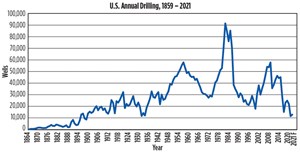
There are only 135 wells separating 2020 from 1931, but that was enough to throw 2020 all the way back to 1898. There were 11,581 wells in 2020, and 11,716 wells in 1931. And the well total in 1898 was just 8,644. This is all very visible in the special, all-time, U.S. historical drilling chart that we have constructed from our records, Fig. 1. And this low point was reached, in spite of the fact that the fourth-quarter uptick in rig count was enough to raise the 2020 well total about 740 wells over our mid-year prediction, or a difference of about 7%.
Although this latest downturn was forecast as end-of-times by many industry analysts, in reality, it’s just another bust. But the pandemic, combined with the inauguration of the Biden Administration and its green initiatives, has initiated a contraction that will have a lasting impact on U.S.-based companies for many years to come. In February, ExxonMobil reported a $22.4-billion loss for 2020, the company’s first annual loss since the 1999 merger that created the nation’s largest oil company. Chevron reported a 2020 loss of $5.5 billion, compared with earnings of $2.9 billion in 2019. ConocoPhillips said it lost $2.7 billion in 2020, compared with a $7.2-billion profit in 2019.
Gulf of Mexico. With the limitations of the unconventional plays becoming more apparent, operators plan to increase drilling activity in the Gulf of Mexico. World Oil predicts a 9.4% increase in drilling and an 8.1% jump in total footage in 2021. In the GOM, average time from discovery to first production has been cut in half over the last four to five years, and final investment decision to first production has declined 33% (Wood Mackenzie). These increased efficiencies are a step in the right direction. They could lead to a modest recovery in deepwater drilling during 2021-2022.
U.S. REGIONAL ACTIVITY
World Oil estimates that nationwide drilling was down 47.7% in 2020, due mainly to a catastrophic drop in demand for fuel caused by Covid-19. However, with a floor set under oil prices, combined with massive government stimulus and the potential for recovering demand, we forecast an 11.5% increase in 2021, Table 1. As expected, the Permian will remain the major target for companies seeking to add oil reserves. We also expect operators working other oil-rich shale plays in North Dakota and Oklahoma, to boost drilling by 17% and 10%, respectively, while Ohio and Wyoming will be leading a rebound in the gas plays.
Texas. Shale drilling will continue to dominate the Lone Star State. Texas is still benefiting from the relentless pace of activity during the boom era. In spite of the collapse in drilling activity in 2020, operators still managed to produce 4.7 MMbopd in November, just a 12.7% y-o-y decline. However, the significant amount of crude output in remote areas forces operators to flare vast quantities of casinghead gas to capture the liquids. In 2020, operators were flaring enough gas to meet the residential demand across the whole of Texas. The surplus supply was so extreme, that natural gas prices at the Permian’s Waha hub reached a record low of minus $9.00/MMBtu in April 2020. In January 2021, RRC Commissioner Jim Wright announced that he would deny most requests for exceptions to Statewide Rule 32 governing flaring permits to: gather more details on the need to flare; and to inquire about the timeline for sufficient infrastructure to take gas to market.
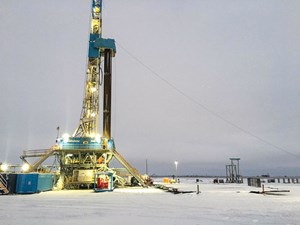
In spite of the state’s stricter stance on flaring, Permian basin operators working in RRC District 8 plan to increase drilling activity 8%, with an accompanying boost in footage of 8.3% in 2021, Fig. 2. In District 7C, World Oil forecasts a surprising 21% increase in well spuds and total footage. In the heart of the Eagle Ford in District 1, operators plan to ramp-up drilling 14%, with an accompanying increase in footage of 15%.
Despite an oversupply of natural gas in West Texas, we predict Districts 4 and 10 will enjoy 76.4% and 5% increases in drilling activity, respectively. Similarly, gassy districts 8A, 5 and 9 also will increase, with gains of 9%, 7%, and 1.6% respectively. In East Texas’ mature Panola gas area in District 6, drilling and footage is projected to rebound 13%. World Oil forecasts total combined activity in Texas will increase 11.4% during 2021, with footage up 10.9%. Several significant mergers and acquisitions during 2020 have reduced the numbers of major players in the Permian and Eagle Ford.
Southeast. In northern Louisiana, a build-up in the area’s DUC inventory, along with excessive amounts of natural gas from other shale plays, will force operators to maintain activity in the Haynesville shale at 299 wells, the same as drilled in 2020. Activity by smaller companies also will slow in the state’s mature shallow oil fields. In southern Louisiana, footage is forecast to slump 8%, with well spuds down 9%. Combined, Louisiana will suffer a 1.4% decline in wells and a 1% reduction in footage during 2021. In Florida, a significant expansion project at one established field will boost the state’s activity from one well in 2020 to 12 wells this year. In Arkansas, Mississippi and Alabama, activity remains slim. And while drilling in these states is only a fraction of pre-2016 levels, all three states will experience moderate gains in activity during 2021.
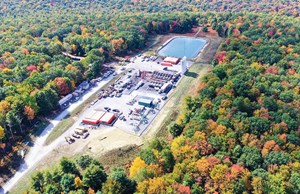
Northeastern states. After demand fell, due to Covid-19, LNG buyers around the world cancelled more than 100 U.S. cargoes, as prices for the fuel collapsed to record lows in Europe and Asia. What’s more, there have only been orders for six LNG carriers placed this year. However, with the rate of cancellations on the decline and an increase in orders expected, it is likely demand for Marcellus-Utica gas, and LNG exports from the Cove Point LNG facility in Maryland, will improve slightly in 2021. After impressive development during the shale boom, drilling activity in Pennsylvania has leveled off and is forecast to improve 1%, with a footage increase of 1%, too, Fig. 3. However, in West Virginia, World Oil forecasts a modest drop, with total wells and footage projected to decrease 5.6% in 2021. The average well should TD around 14,000 ft in the Mountain State. We forecast Ohio’s well activity will improve 5.6%, but total footage is projected to decline 6.2% in 2021 as operators reduce horizontal well lengths to improve ROI.
Midwest. World Oil predicts activity levels will experience a noticeable surge in this region. In Michigan, state officials project a 10% increase in spuds with an 8% improvement in total footage during 2021. The increase is most likely due to higher commodity prices and an increase in rig availability. However, Illinois’ state regulatory agency, the Office of Oil and Gas Resource Management, is predicting a 44% increase in drilling activity and a 43% jump in footage. Indiana’s operators cite an increase in oil price and the prospect of recovering demand, as Covid vaccines take hold, as major factors driving new drilling projects. Because of this optimism, we forecast a 5.0% increase in spuds and total footage during 2021 in the Hoosier State.
Mid-continent. Despite disappointing results in the SCOOP and STACK plays of Oklahoma, operators are expected to increase drilling operations in the state, to take advantage of updated technologies and completion practices. During 2021, we predict that Oklahoma’s drilling activity will increase 10%, with a 10% boost in footage. Activity in the Sooner State continues to be dominated by Continental, Newfield, Devon and Cimarex.
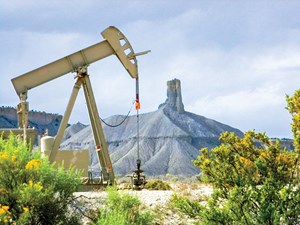
In the oil-rich Bakken shale of North Dakota, drilling remained relatively consistent during the 2017-2019 recovery era. However, in 2021, World Oil forecasts that drilling and footage will increase 17% and 16%, respectively. We predict the trend to laterals approximately two miles long will continue through 2021, with some wells reaching an MTD of 21,000 ft. Oil transport from the remote location is still an issue, but the region’s entrenched operators will continue to support their large drilling and completion investments.
In conventionally oriented Kansas, operators continue to drill relatively shallow oil and gas wells to maintain production. But with the shale plays waning, investors are starting to shift attention back to traditional prospects that don’t require high-cost horizontal drilling and staged fracing techniques. As a result, we predict a 26% increase in total wells and a 38% jump in footage in 2021.
Rocky Mountain states. The pro-green political climate taking hold in Colorado has damaged the state’s oil and gas industry. Despite a hostile political climate, it appears the established operators working the state are not willing to abandon their producing properties in search of more favorable drilling sites. As such, we project 7.3% more wells and footage in 2021. However, the 2020 drilling slowdown has hurt Colorado’s crude production, which dropped to 390,000 bopd in November, down 31% from a year earlier.
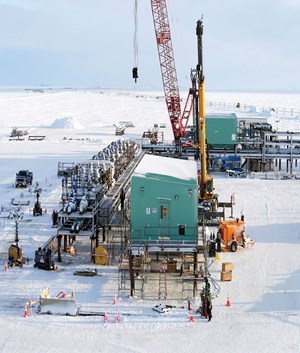
On the Wyoming side of the Niobrara shale, operators plan a 24.4% uptick in drilling activity, making 24.4% more hole in 2021. The state should start benefiting from the negative political climate in neighboring Colorado and a push to drill on federal lands before leases expire. The catastrophic decline in drilling activity in 2020 caused production to decline to 237,000 bopd in November, a drop of 20% on a y-o-y basis. In northeastern Utah’s multi-horizon Uinta basin, a boom scenario is predicted, as operators expedite activity to lock in held-by-production rights on federal lands as leases expire, Fig. 4. Drilling activity is forecast to increase 74%, and footage should improve 50% in 2021. Approximately 67% of the state’s mineral acreage is controlled by the U.S. BLM.
Although New Mexico was late to the Permian shale boom, operators have started to focus more attention on the region and its prolific Bone Spring formation. Accordingly, we predict a meaningful upturn in drilling activity during 2021, as operators rush to drill federal lands before the lease term expires. We forecast the state will experience an increase of 8.4% in well spuds and an 8.5% improvement in footage drilled during 2021.
On the West Coast, California’s drilling activity has been an up-and-down proposition over the past several years. However, the state has been remarkably resilient over the past several years, especially considering practically no exploratory drilling for the past decade. In 2021, onshore operators are expected to reduce drilling just 1.1%, with total footage down 2.6%. Compared to last year, 2021 should be a boom scenario for drilling offshore the Golden State, with 12 new wells projected for 2021, compared to zero drilled in 2020. As in previous years, most drilling is conducted by just four companies. The erratic drilling activity is starting to take a toll on the state’s production. In November, operators managed to pump just 370,000 bopd, 13% less than produced in November 2019.
Several factors have hampered the development of Alaska’s offshore drilling industry, with no meaningful recovery in sight. However, offshore work in the Cook Inlet will increase, with three wells forecast for 2021, two more than drilled in 2020. Onshore drilling activity and total footage on the North Slope are both projected to increase 13.8% in 2021, Fig 5.


- Shale technology: Bayesian variable pressure decline-curve analysis for shale gas wells (March 2024)
- The last barrel (February 2024)
- E&P outside the U.S. maintains a disciplined pace (February 2024)
- U.S. producing gas wells increase despite low prices (February 2024)
- Executive viewpoint: TRRC opinion: Special interest groups are killing jobs to save their own (February 2024)
- U.S. drilling: More of the same expected (February 2024)
- Applying ultra-deep LWD resistivity technology successfully in a SAGD operation (May 2019)
- Adoption of wireless intelligent completions advances (May 2019)
- Majors double down as takeaway crunch eases (April 2019)
- What’s new in well logging and formation evaluation (April 2019)
- Qualification of a 20,000-psi subsea BOP: A collaborative approach (February 2019)
- ConocoPhillips’ Greg Leveille sees rapid trajectory of technical advancement continuing (February 2019)

